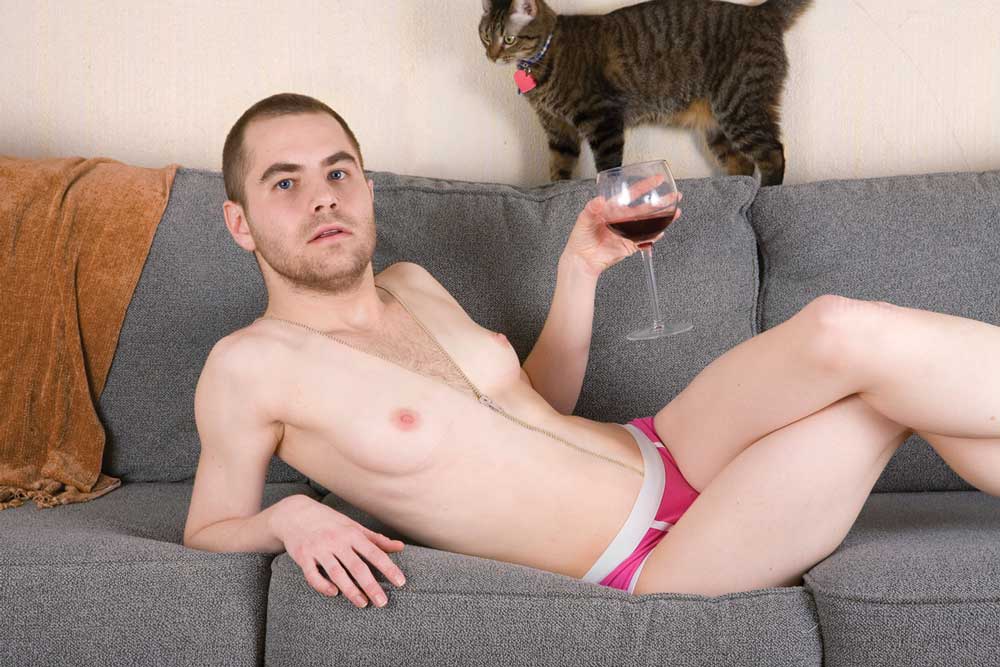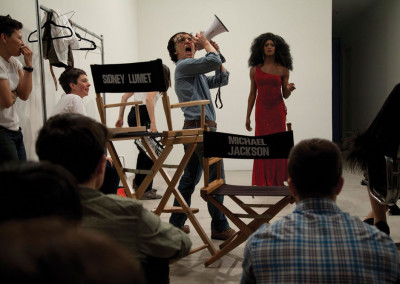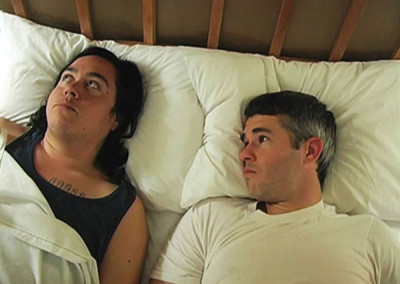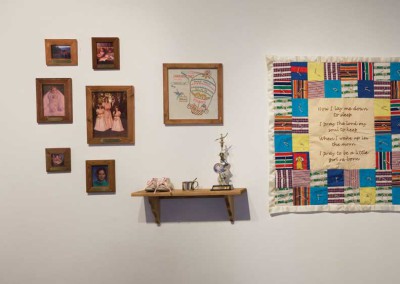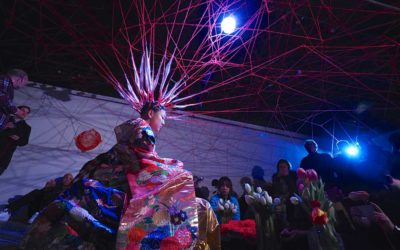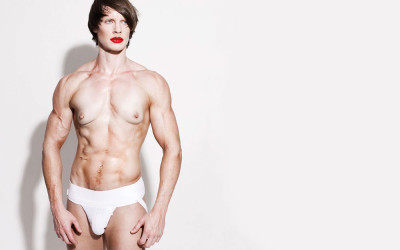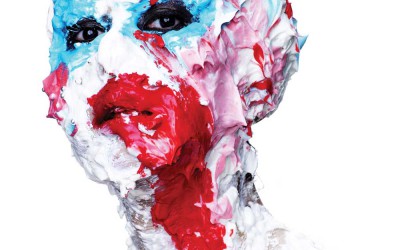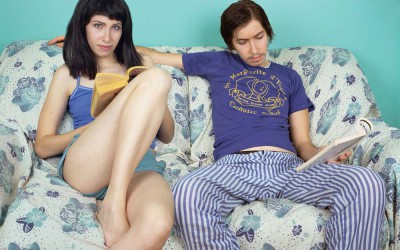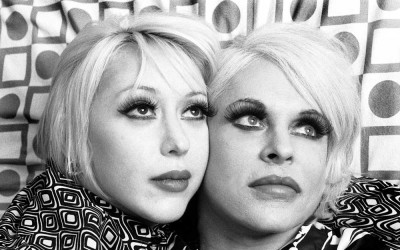Strange Bedfellows
Text JF. Pierets
Strange Bedfellows is a nationally traveling exhibition and catalogue exploring collaborative practice in queer art making. With names such as Annie Sprinkle, Amos Mac and Julie Sutherland they travel the world. Curator Amy Cancelmo is redefining authorship and ‘queerin’ the singular artist/author paradigm. An interview.
When and why did you come up with the idea?
Well my master degree is in Queer Art History, so I had been spending quite a bit of time looking at historical queer art. Since so much of what can be clearly defined within that category is either performative, documentary or politically motivated, there is a huge amount of collaboration that happens naturally. In my thesis I worked specifically with community portraiture as a means of social and political change or reflection of shift in cultural ideas. What recurred in that research was the problematic nature of authorship, specifically when photographers were working with other artists and performers. Who is really the artist that moment, the one documenting it, or the one living it? How do you define authorship of a documentary photograph? The idea for the show started as a series of questions. Why are there so many collaborative queer artworks? Is there something inherently queer about collaboration, or something inherently collaborative about queerness? The answer to both questions for me is yes. Queers have long relied on collaborative practice for a variety of reasons, not the least of which have been physical and emotional safety or political presence. I see collaboration and queerness both as spaces for social, political, personal, and artistic revolution. Collaborative practice, like queer politics, positions itself in radical opposition to commodification- and traditional concepts of identity. I like to think of collaborative practice as a queering the concept of the singular artist or author.
What’s your personal definition of queer?
Queer is often used as a blanket term to attempt and to encompass the range of diversity within the LGBTQQI population. Yet not all homosexuals define themselves as queer and not all those who define as queer are homosexual. Queerness can be defined as both an expression of non-heteronormative sexuality or gender expression or as a social and political stance. Queer is a noun, but it is also a verb.
On your blog, you write: “It is my hope that the exhibition will continue to travel and evolve, raising new questions about the role collaboration plays in queer life and artistic practice.” Can you explain this to someone who hasn’t been in touch with queer art?
It’s funny because ‘community’, for better or worse, is a word that is often thrown around in relation to queerness. The Queer Community. The Gay Community. The Lesbian Community. The Transgender Community, etc. In a sense queer people are often though about as identifying as a multiple, even from an uninformed perspective. Like we are all part of a secret club or something, sharing a common experience. But the truth is that there are so many different ways to experience sexuality, politics, gender or whatever else makes us self define as queer. That’s what I’m interested in. The radical ways in which people define queer for themselves, and how they are incorporating that into their artwork and who they are working with to make it. Maybe a hundred years ago there just wasn’t an audience for queer art outside of ‘the community’ and queer artists relied on each other and worked together to make some of the most interesting artwork in history. Maybe that’s still true to an extent. Maybe it’s a part of being a minority, being an outsider. To me, being queer is a collaborative effort. Partially because you’re defining yourself by who you relate to and partially because you are constantly in dialogue with what you are not. ‘Queer’ doesn’t exist without ‘normal’.
How does a traveling exhibition work?
The travelling happened pretty organically. I first proposed this show to be presented at Root Division in San Francisco and was lucky enough to get funding to present it as part of the National Queer Arts Festival from the Queer Cultural Center. I was so thrilled by all the support from both organizations and the artists I invited to participate, many of whom I had never worked with before. There are so many artists working in collaborative practice! And a show about collaboration begs to keep evolving with more and more collaborators. So I proposed the show to the College Art Association’s Queer Caucus for the Arts and they were extremely supportive as well. They decided to feature it as their sponsored exhibition for the upcoming Chicago conference (Feb 2014).
‘That’s what I’m interested in. The radical ways in which people define queer for themselves, and how they are incorporating that into their artwork and who they are working with to make it.’
I just had to find a venue. I reached out to a few colleagues, and proposed the show to several schools and was really lucky. Queer studies is expanding as an academic field, both in the arts and the humanities, so I think many schools are excited to bring the show to open up a dialogue with their faculty and students. I love it because I get to travel to all these schools and talk to students, meet faculty, meets more queer artists.I get to share the important work the artists in the show are doing and scout out local work to feature as well. I am continuing to expand the show with each stop, adding regionally specific artists to the roster and hopefully inspiring new collaborations. So far I’m showing at all university and college galleries, but I’m open to other types of venues as well as it continues to travel.
How did you select your artists?
A lot of the artists I selected for the San Francisco exhibition, I knew in some capacity or worked with them before. I’ve been doing research in the field for a while now, so I had a pretty good list of people I wanted to work with. There are still others I’m hoping to snag for the show as it passes through their part of the country. I selected the artists because I found something interesting about the role of collaboration in their practice. The artists range in their queer identities, politics, strategies and reasons for collaboration. I attempted to present a diverse look at roles in contemporary queer art practice, including the personal, performative and political ones.
About the first exhibitions; how did it go? What where the reactions and who are your visitors?
The first exhibition at Root Division was really well received. I was humbled by the amount of people that came to the opening, including many of my artistic and professional idols! Root Division has a great group of followers and having Strange Bedfellows featured as part of the National Queer Arts Festival added a whole new audience. Several people told me they were deeply moved by the work, which is always nice to hear. I think the work in this show is really powerful and I’m glad that translates. We also had a great turnout for the panel discussion and catalogue release party, which was really encouraging. It’s hard to get people to come out to an academic panel, but we had great speakers such as Amos Mac, Tina Takemoto, Chris Vargas & Greg Youmans, EG Crichton, Annie Sprinkle & Beth Stephens. You can say it was an engaging and fun panel.
Strange Bedfellows is an ongoing project.
It is! I currently have the show booked for four venues but I’m still looking for more! A project that evolves while traveling can remain interesting for quite some time. I love getting to work with new artists and getting to know what’s happening in queer art in different cities.
Any future exhibition plans?
How about an international exhibition? A European tour perhaps? Can you help with that Fleur?
www.amycancelmo.wordpress.com
www.strangebedfellowsexhibition.wordpress.com
Related articles
Ayakamay
Artist Ayakamay explores the interrelationship between photography and performance. She simultaneously appropriates traditional Japanese cultural aesthetics and creates a dialogue with contemporary American urbanity and femininity…..
Martin(e) Gutierrez
Artist and Et Alors? #14 cover model Martín(e) Gutierrez investigates identity, through the transformation of physical space and self. Interested in the fluidity of relationships and the role of gender within each, s/he employs mannequins as…..
Heather Cassils
Cassils first caught our eye in the ‘Telephone’ video, where the performance artist and personal trainer made out with Lady Gaga in the prison yard. Intrigued about this appearance, we discovered a highly intelligent artist who pushes the…..
Pyuupiru
‘I can never create work that lies.’ With those words Japanese visual artist Pyuupiru captures exactly the sensation an audience experiences when looking at her work. Starting off as a creator of eccentric costumes designed as clubwear that distorted her…..
Alone Time
JJ Levine is a Montreal-based artist working in intimate portraiture. Levine’s photography explores issues surrounding gender, sexuality, self-identity, and queer space. In the series ‘Alone Time’ Levine aims to make visually confusing images…..
Genesis Breyer P-Orridge
First Third Books released an ambitious new project on the life of Genesis Breyer P-Orridge – music pioneer, artist and body evolutionist. Independently produced in limited numbers, this is a superb quality book devoted to the controversial life and…..
